
Backyard wheat conclusions
 The
majority of our
wheat maxed out
around knee-high and the heads were far smaller than they should have
been. I suspect that the main problem was planting too thickly
because the wheat along the edge of the path where most of the plants
got trampled and died was over twice as tall as average and had seed
heads three times as long. But I also should have left the
chickens in that pasture longer after they ate up last summer's
buckwheat so that they could fertilize the field a little more.
Live and learn.
The
majority of our
wheat maxed out
around knee-high and the heads were far smaller than they should have
been. I suspect that the main problem was planting too thickly
because the wheat along the edge of the path where most of the plants
got trampled and died was over twice as tall as average and had seed
heads three times as long. But I also should have left the
chickens in that pasture longer after they ate up last summer's
buckwheat so that they could fertilize the field a little more.
Live and learn.
Since so many of the
stalks were puny, I knew shocks wouldn't have enough structural
integrity to dry the wheat. Instead, I tied clumps with baling
twine (leftover from straw bales) and hung them up with the
garlic under our
"porch." I might try to thresh a bit of the wheat when it's
thoroughly dried, but at the moment I'm thinking that it will make a
good treat for the chickens as is. If I threw a handful of wheat
on the stalk into the coop, the chickens could pick through to get the
grain, then scratch the straw around to refresh their deep
bedding.
Want more in-depth information? Browse through our books.
Or explore more posts by date or by subject.
About us: Anna Hess and Mark Hamilton spent over a decade living self-sufficiently in the mountains of Virginia before moving north to start over from scratch in the foothills of Ohio. They've experimented with permaculture, no-till gardening, trailersteading, home-based microbusinesses and much more, writing about their adventures in both blogs and books.
Want to be notified when new comments are posted on this page? Click on the RSS button after you add a comment to subscribe to the comment feed, or simply check the box beside "email replies to me" while writing your comment.

Jessie --- Mark estimates our wheat area is about 600 square feet. We got about 16 big handfuls of wheat stalks, like the ones shown in the picture. I'm not sure how much wheat that will be, but it's also at the very low end of what you should expect since I gave it absolutely no care and made the mistakes I mentioned in the post.
You might be interested in reading some of my previous posts about grains including:
Grain varieties suitable to the backyard
How much space do I need to grow my own grains?
Growing grains for homemade livestock feed
Another thing to keep in mind is that chickens need variety in their grains. I've read that you shouldn't feed your chickens more than 15% of a combo of oats and barley, more than 30% wheat, or more than 25% peas. Too much of the same kind of grain can give your chickens diarrhea, and tannins in the peas make it hard for chickens to digest protein. That said, I haven't read anywhere about too much corn being bad for chickens (although it might be, and is pretty low protein.)
Which is probably more information than you want or need. I think that in your shoes, if I had a ten by ten (or even five by five) foot plot to devote to chicken feed, I'd plant sunflower seeds and/or field corn.
This is from a friend of mine in Louisa VA. You may need to expand your space for growing wheat, but it might be worth it.
We now are grinding our own wheat, and making bread using a new method. Believe it or not, this method completely eliminates the second rise and the kneading that goes along with it. Instead, the ingredients are mixed and the dough kneaded in a mixer for about 10 minutes. Then the dough is placed directly into baking pans and left to rise. Baking begins when the dough has risen.
I've made my lightest-ever whole wheat bread using this method. In the past, my whole wheat bread has been dense and heavy. now it's the same consistency as homemade white bread, or even lighter. I once over-kneaded in the mixer and ended up with whole wheat AIR BREAD! It really was that light.
Being the experienced baker you are, you probably know all the techniques there are, but if not, I highly recommend the book "No More Bricks" by Lori Viets. http://www.amazon.com/Bricks-Successful-Whole-Grain-Bread/dp/061525330X It's a quick read, but packed with useful information for future reference.
Not only does she describe the technique, she explains why freshly-ground flour is more nutritious than packaged flour.
Sheila